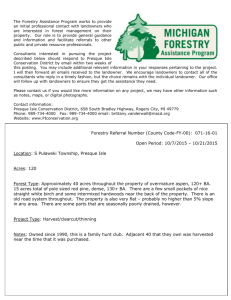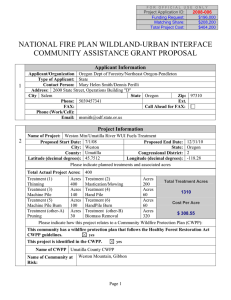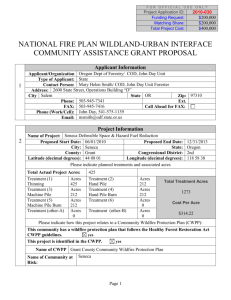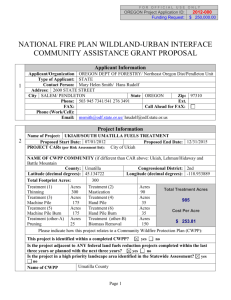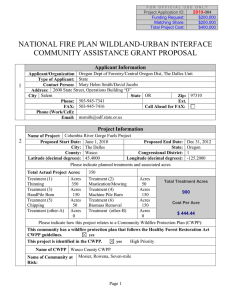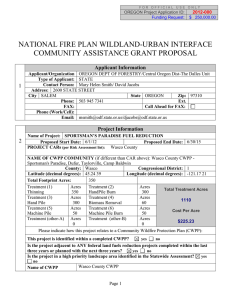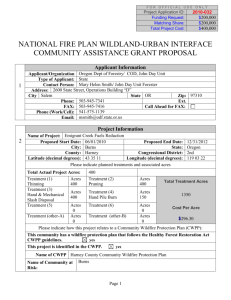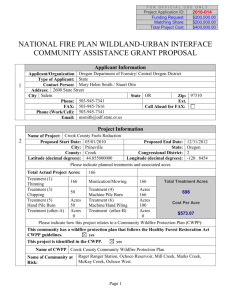NATIONAL FIRE PLAN WILDLAND-URBAN INTERFACE COMMUNITY ASSISTANCE GRANT PROPOSAL 1
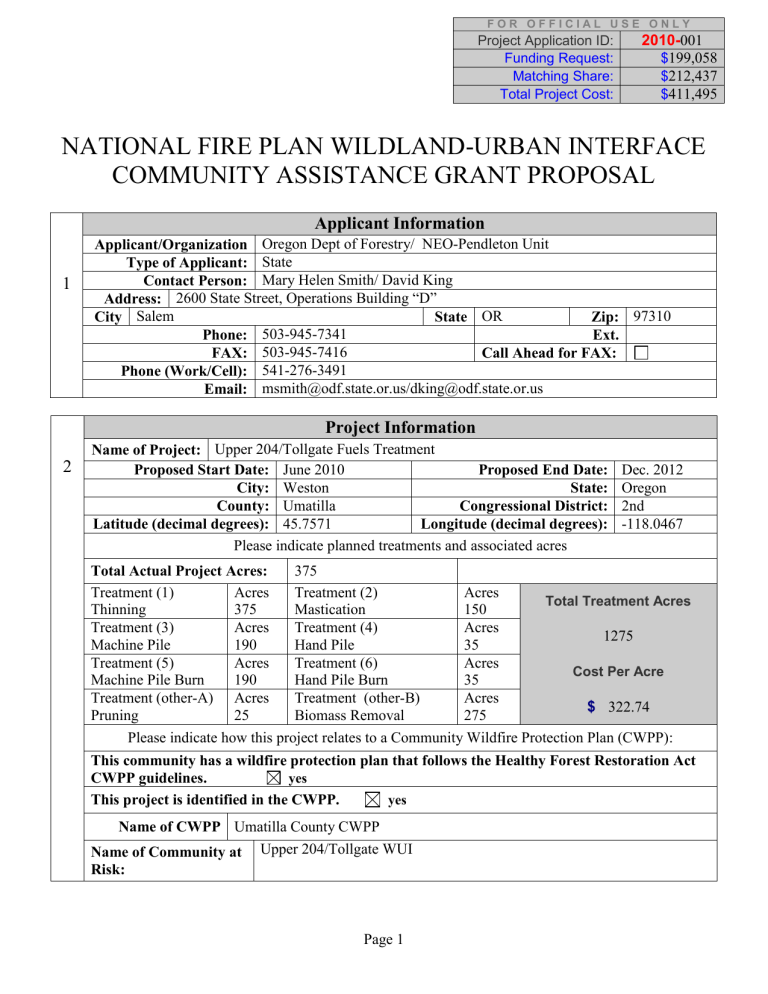
2
1
F O R O F F I C I A L U S E O N L Y
Project Application ID: 2010001
Funding Request: $ 199,058
Matching Share:
Total Project Cost:
$ 212,437
$ 411,495
NATIONAL FIRE PLAN WILDLAND-URBAN INTERFACE
COMMUNITY ASSISTANCE GRANT PROPOSAL
Applicant Information
Applicant/Organization Oregon Dept of Forestry/ NEO-Pendleton Unit
: State
Contact Person: Mary Helen Smith/ David King
Address:
2600 State Street, Operations Building “D”
City
:
Salem
Phone: 503-945-7341
FAX: 503-945-7416
State
:
OR Zip: 97310
Ext.
Call Ahead for FAX:
Phone (Work/Cell): 541-276-3491
Email: msmith@odf.state.or.us/dking@odf.state.or.us
Project Information
Name of Project: Upper 204/Tollgate Fuels Treatment
Proposed Start Date: June 2010
City: Weston
County: Umatilla
Latitude (decimal degrees): 45.7571
Proposed End Date: Dec. 2012
State: Oregon
Congressional District: 2nd
Longitude (decimal degrees): -118.0467
Please indicate planned treatments and associated acres
Total Actual Project Acres: 375
Treatment (1)
Thinning
Treatment (3)
Machine Pile
Treatment (5)
Machine Pile Burn
Treatment (other-A)
Pruning
Acres
375
Acres
190
Acres
190
Acres
25
Treatment (2)
Mastication
Treatment (4)
Hand Pile
Treatment (6)
Hand Pile Burn
Treatment (other-B)
Biomass Removal
Acres
150
Acres
35
Acres
35
Acres
275
Total Treatment Acres
Cost Per Acre
$
1275
322.74
Please indicate how this project relates to a Community Wildfire Protection Plan (CWPP):
This community has a wildfire protection plan that follows the Healthy Forest Restoration Act
CWPP guidelines.
yes
This project is identified in the CWPP.
yes
Name of CWPP Umatilla County CWPP
Name of Community at
Risk:
Upper 204/Tollgate WUI
Page 1
3
Project Area Description
All information for the project must fit into the space provided below. Attachments will not be considered by the review committee.
Provide a brief overview of the project and the project area. (If applying for a fuels reduction project, identify vegetation types, fire regime) [1500 Characters Maximum]
The Upper 204/Tollgate WUI is the #1 priority project submitted from the Umatilla County CWPP for fuels treatment work and is rated a high risk area in the Statewide Fire Risk Assessment. Over
800 homesites and cabins are located within this WUI. Fuels consist predominantly of Fire Regime
Group III and Group IV (mixed conifer). Approximately 70% of the area is in Fire Regime
Condition Class 3 and another 15% in Class 2, meaning that the majority of the area has been significantly altered from historical stand structure and species composition. Grand fir encroachment, dense understory vegetation, and sub-alpine fir fuel types create a high ladder fuel loading. Insect damage/mortality and fire exclusion are having landscape-wide impacts. These factors have increased the risk of a catastrophic crown fire in this heavily populated WUI. Much of the area is similar to the fuel type found in the nearby School Fire (2005) and Columbia Complex
(2006) that each burned over 50,000 acres and destroyed numerous structures. In 2005, the Burnt
Cabin Fire burned almost 2000 acres of USFS lands and threatened more than forty private homes and cabins in this immediate area.
This proposal would provide cost share funding for fuels reduction projects by targeting woodland owners having dense young growth and stagnant stands on their properties. Defensible space standards would be met around home-sites, and community firebreaks would be established where feasible and effective. Educational materials would be distributed to WUI landowners.
This project is adjacent to the planned USFS Tollgate Analysis Area fuels treatment project. ODF and private landowners are active participants in the current collaborative fuels treatment effort being developed on federal lands in this area. This grant would provide private lands funding for cross boundary projects involving both federal and private ownerships.
4
Project Timeline
All information for the project must fit into the space provided below. Attachments will not be considered by the review committee.
Provide a timeline for the project. [500 Characters Maximum]
June 2010 - landowner outreach and educational material distribution
July 2010 - July 2011 - landowner sign-up, project prioritization, application approval
July 2010 - Sept 2012 - technical layout of projects, compliance monitoring, payment processing
December 2010 - annual accomplishment reporting
December 2011- annual accomplishment reporting
Sept - Dec 2012 - final approval and payment processing for all project work
Page 2
6
5
Scope of Work
All information for the project must fit into the space provided below. Attachments will not be considered by the review committee.
Provide a brief scope of work which clearly describes how grant funds will be spent. (This should be more specific than the project description) [1500 Characters Maximum]
The risk of catastrophic fire will be reduced by treating 375 acres of overstocked, fire-prone timber stands in the WUI. Fuel reduction techniques will include noncommercial thinning, pruning, removal of heavy accumulations of dead and down material and slash treatment, including mastication and piling. Biomass utilization, including chipwood, firewood, hog-fuel and mulching will be encouraged.
A professional forester and fire behavior specialist will formulate project specifications that will determine appropriate project locations, treatment timing, and spacing guidelines. These projects will return stands to more historical species and stocking distribution, thereby reducing the possibility of catastrophic fire while also providing sound silvicultural treatments that promote overall forest and watershed health. Project work will be accomplished by landowners and local contractors, thereby benefitting the local economy. Funding will be used to administer the grant, provide technical assistance to landowners, and provide private landowner cost share incentive on
375 acres of project work.
In addition, funding will be used for homeowner education by distributing "Living with Fire" brochures, Firewise defensible space pamphlets and other fire prevention materials. Landowner education will also occur through personal contacts.
Interest in this project is high and ODF has successfully implemented fuels projects in other nearby
WUI areas of the county, ensuring the positive outcome of this project. In addition, the timing of the adjacent USFS fuels treatment projects would mesh very well with this proposal, and help create high interest and participation levels on private lands. This is an area that is subject to the requirements of SB360, and this grant would aid landowners working to make their properties wildfire survivable.
Interagency Collaboration
All information for the project must fit into the space provided below. Attachments will not be considered by the review committee.
Specify the private, local, tribal, county, state, federal and/or non-governmental [501(c)(3)] organizations that will contribute to or participate in the completion of this project. Describe briefly the contributions each partner will make (i.e. – donating time/equipment, funding, etc.)
[500 Characters Maximum]
Project need was confirmed at a CWPP Steering Committee meeting attended by USFS, BIA, ODF, county fire defense board chief and homeowners.
Landowner interest in fuels work is high - a SB 360 meeting in this WUI was attended by over 100 people. Landowners will provide 25% of contractual funds for firebreaks. Currently, a collaborative effort is in progress to help determine and implement HFRA projects on adjacent USFS lands.
Interest and attendance by the public at these planning meetings has been high.
ODF - personnel time, technical expertise, equipment and education
Local RFD - personnel time and education
Page 3
7
Project Longevity / Maintenance
All information for the project must fit into the space provided below. Attachments will not be considered by the review committee.
Clearly describe how the proposed treatments will be maintained over time. [500 Characters
Maximum]
Landowners sign an agreement to maintain the project for 10 years. ODF and East Umatilla County
RFD will provide ongoing monitoring during patrols, fire prevention work, and frequent visits to other fuels projects and forest operations in the area. Three years after project completion, participating landowners will be mailed fire prevention education and vegetation management information. Five years after completion, an on-site assessment will be scheduled and further assistance provided.
8
Biomass Utilization
All information for the project must fit into the space provided below. Attachments will not be considered by the review committee.
For the purpose of this application, biomass utilization is defined as any practicable end-use of the material that has value, or the trading of capital for the woody material.
Biomass from treatment(s) will be utilized. (check one) yes no
1) If yes, how is it planned to be used, or what is the end-result (wood products, steam/energy, mulch etc.) [500 Characters Maximum]
Biomass will be utilized to the fullest extent possible as new markets emerge and current market conditions change. Chip logs will be removed from about 205 acres and utilized for wood products as clean chips. Hog-fuel will be removed from about 20 acres and utilized by a local mill to fire kilns.
Landowners and contractors will remove firewood, fence posts and poles on another 50 acres. Also, on-site mastication, which recycles nutrients and avoids burning, will occur on about 150 acres.
2) Identify company or contractors involved in project utilization. [250 Characters Maximum]
Kinzua Resources, Pilot Rock - chip logs, hog-fuel for wood-fired kilns
Boardman Chip Co., Boardman - chip logs
Boise Solutions, Umatilla - chip logs
Boise Solutions Wallula Pulp Mill, Wallula Jct.
Several project landowners & contractors - firewood, posts, poles
3) Estimate anticipated value of biomass to be removed ($/Green Ton; $/Bone-dry Ton;
$/Hundred Cubic Feet (CCF), $/Acre Treated) [250 Characters Maximum]
Chip logs - 205 acres; 2050 tons x $30/ton = $61,500
Hogfuel - 20 acres; 160 tons x $20/ton = $3,200
Firewood - 30 acres; 60 cords x $160/cord = $9,600
Poles - 10 acres; 500 poles x $6/pole = $3000
Posts - 10 acres; 1000 posts x $2/post = $2000
Page 4
Project Budget
Cost Category
Description
Federal
Agency Applicant
Matching Share
Landowners E. Uma. RFPD Total
Personnel
NRS2 Proj Coord $17,980.00
Salem Grant Admin (5%) $6,569.00
Subtotal $24,549.00
Fringe Benefits
Field OPE $8,990.00
Salem Grant Admin (5%) $3,384.00
Subtotal $12,374.00
Travel
2500 miles x $.57
$1,425.00
$0.00
Subtotal $1,425.00
Equipment
$0.00
$0.00
Subtotal $0.00
$107,200.00
$0.00
$0.00 $0.00
$107,200.00
$0.00
$52,800.00
$0.00
$52,800.00
$2,500.00
$0.00
$2,500.00
$0.00
$0.00
$0.00
$0.00
$0.00
$0.00
$0.00
$0.00
$0.00
$0.00
$0.00
$0.00
$4,000.00
$0.00
$4,000.00
$0.00
$0.00
$0.00
$0.00
$0.00
$0.00
$0.00
$0.00
$0.00
$129,180.00
$6,569.00
$135,749.00,
$61,790.00
$3,384.00
$65,174.00
$3,925.00
$0.00
$3,925.00
$0.00
$0.00
$0.00
Supplies
Postage, pamphlets, misc $1,000.00
$0.00
Subtotal $1,000.00
Contractual
Landowner cost share $137,813.00
$0.00
$0.00
$0.00
$0.00
$0.00
$0.00
Subtotal $137,813.00
$0.00
$0.00
$0.00
$0.00
$45,937.00
$0.00
$45,937.00
$0.00
$0.00
$0.00
$0.00
$0.00
$0.00
$1,000.00
$0.00
$1,000.00
$183,750.00
$0.00
$183,750.00
Other
NEO +EOA Indirect
Agency Indirect (5%)
Total Costs
$11,944.00
$9,953.00
$0.00
$0.00
$0.00
$0.00
Subtotal $21,897.00
$0.00 $0.00
$199,058.00
$162,500.00
$45,937.00
$0.00
$0.00
$0.00
$4,000.00
Project (Program) Income 1
(using deductive alternative)
$11,944.00
$9,953.00
$21,897.00
$411,495.00
1 Program income is the gross revenue generated by a grant or cooperative agreement supported activity during the life of the grant.
Program income can be made by recipients from fees charged for conference or workshop attendance, from rental fees earned from renting out real property or equipment acquired with grant or cooperative agreement funds, or from the sale of commodities or items developed under the grant or cooperative agreement. The use of Program Income during the project period may require prior approval by the granting agency.
